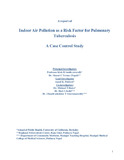Please use this identifier to cite or link to this item:
https://hdl.handle.net/20.500.14356/786Full metadata record
| DC Field | Value | Language |
|---|---|---|
| dc.contributor.author | Smith, Kirk R, Professor | |
| dc.date.accessioned | 2012-12-28T20:49:55Z | |
| dc.date.accessioned | 2022-11-08T10:20:37Z | - |
| dc.date.available | 2012-12-28T20:49:55Z | |
| dc.date.available | 2022-11-08T10:20:37Z | - |
| dc.date.issued | 2009 | |
| dc.identifier.uri | http://103.69.126.140:8080/handle/20.500.14356/786 | - |
| dc.description.abstract | Background: Approximately half of the world’s population and up to 90% of rural households in developing countries still rely on unprocessed solid fuels, such as wood, crop residues or dung cake, for cooking and, sometimes, heating the house[1]. In most of the developing countries, solid fuels are burned in an unvented stove in poorly ventilated kitchens or rooms, throughout the year. As the stoves are not energy efficient, fuels are not burned completely. The incomplete combustion of solid fuel releases a complex mixture of organic and inorganic compounds, such as particulate matter [2, 3], carbon monoxide, polyorganic material, polyaromatic hydrocarbons (PAH), formaldehyde, naphthalene etc[1]. Several studies have suggested that exposure to indoor air pollution (IAP) from household solid fuel use increases the risk for several diseases, particularly in women and children, who receive the highest exposures. For example, based on the strength of evidence from meta-analysis[4], Smith et al (2004) have reported strong evidence of association of IAP with Acute Lower Respiratory Infection (ALRI in children <5 years), Chronic Obstructive Pulmonary Disease (COPD), and lung cancer (from exposure to coal smoke: for women and men ≥ 30 years). Although as sociations with asthma, cataracts (and other eye conditions), adverse pregnancy outcomes (including low birth weight), other cancers, heart disease, and tuberculosis (TB) have been found, they are not as robust as those for ALRI, COPD and lung cancer. In the case of cataracts or lens opacity and TB, there exist only a few studies of the relationship with indoor air pollution, and they all have important limitations. | en_US |
| dc.language.iso | en_US | en_US |
| dc.publisher | School of Public Health, University of California,Berkeley | en_US |
| dc.subject | Indoor Air Pollution | en_US |
| dc.subject | Tuberculosis | en_US |
| dc.title | Indoor Air Pollution as a Risk Factor for Pulmonary Tuberculosis | en_US |
| dc.title.alternative | A Case Control Study | en_US |
| dc.type | Technical Report | en_US |
| Appears in Collections: | Post Graduate Grant (PG) Reports | |
Items in DSpace are protected by copyright, with all rights reserved, unless otherwise indicated.

